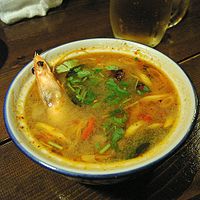Tom yum: Difference between revisions
m Reverted edits by 121.6.240.213 (talk) to last version by 76.105.211.91 |
No edit summary Tag: repeating characters |
||
| Line 9: | Line 9: | ||
Tom yum is characterized by its distinct hot and sour flavors, with fragrant herbs generously used. The basic broth is made of stock and fresh ingredients such as [[lemon grass]], [[kaffir lime]] leaves, [[galangal]], [[lime (fruit)|lime]] juice, [[fish sauce]] and crushed [[chili pepper]]s. |
Tom yum is characterized by its distinct hot and sour flavors, with fragrant herbs generously used. The basic broth is made of stock and fresh ingredients such as [[lemon grass]], [[kaffir lime]] leaves, [[galangal]], [[lime (fruit)|lime]] juice, [[fish sauce]] and crushed [[chili pepper]]s. |
||
Tom yum is usually made with [[prawn]]s (''tom yum goong'' or ''tom yum kung''), [[chicken]] (''tom yum kai''), fish (''tom yum pa'' in Laotian and ''tom yum pla'' in Thai), or mixed seafood (''tom yum thale'' or ''tom yum po taek'') and mushrooms - usually [[straw mushrooms]] or [[oyster mushrooms]]. The soup is often topped with generous sprinkling of fresh chopped cilantro ([[coriander]] leaves). |
Tom yum is usually made with [[prawn]]s (''tom yum goong'' or ''tom yum kung''), [[chicken]] (''tom yum kai''), fish (''tom yum pa'' in Laotian and ''tom yum pla'' in Thai), or mixed seafood (''tom yum thale'' or ''tom yum po taek'') and mushrooms - usually [[straw mushrooms]] or [[oyster mushrooms]]. The soup is often topped with generous sprinkling of fresh chopped cilantro ([[coriander]] leaves).<ref>{{cite web | url=htthttp://tomyumrecipe.com/tomyumrecipe/ | title=Illustrated Tom Yum classic recipe}}</ref> |
||
The less popular, and relatively more modern, variety of tom yum is ''tom yum nam khon'' ({{lang-th|ต้มยำน้ำข้น}}), where coconut milk is added to the broth. This adaptation is not to be confused with tom kha - where the [[galanga]] flavor dominates the soup. ''Tom yum nam khon'' is almost always made with [[prawns]], whereas chicken is often used in tom kha (called [[tom kha gai]], "chicken galanga soup"). Its other cousin is less well-known outside Thailand - ''tom khlong''. Sometimes Thai chili jam (''nam phrik phao'', {{lang-th|น้ำพริกเผา}}) is added: this gives the soup a bright orange colour and makes the chili flavor more pronounced. |
The less popular, and relatively more modern, variety of tom yum is ''tom yum nam khon'' ({{lang-th|ต้มยำน้ำข้น}}), where coconut milk is added to the broth. This adaptation is not to be confused with tom kha - where the [[galanga]] flavor dominates the soup. ''Tom yum nam khon'' is almost always made with [[prawns]], whereas chicken is often used in tom kha (called [[tom kha gai]], "chicken galanga soup"). Its other cousin is less well-known outside Thailand - ''tom khlong''. Sometimes Thai chili jam (''nam phrik phao'', {{lang-th|น้ำพริกเผา}}) is added: this gives the soup a bright orange colour and makes the chili flavor more pronounced. |
||
Revision as of 07:49, 6 December 2010
This article needs additional citations for verification. (August 2009) |



Tom yum (Lao: ຕົ້ມຍຳ [tôm ɲam]; Thai: ต้มยำ, [tôm jam], tom yam in the Royal Thai General System of Transcription) is a name for two similar soups originating from Laos and Thailand. The Royal Lao version includes a pinch of rice in the soup, whereas other typical Laotian and Thai versions do not include rice as an ingredient. Tom yum is widely served in neighboring countries such as Malaysia, Singapore, and Indonesia, and has been popularized around the world.
Tom yum is characterized by its distinct hot and sour flavors, with fragrant herbs generously used. The basic broth is made of stock and fresh ingredients such as lemon grass, kaffir lime leaves, galangal, lime juice, fish sauce and crushed chili peppers.
Tom yum is usually made with prawns (tom yum goong or tom yum kung), chicken (tom yum kai), fish (tom yum pa in Laotian and tom yum pla in Thai), or mixed seafood (tom yum thale or tom yum po taek) and mushrooms - usually straw mushrooms or oyster mushrooms. The soup is often topped with generous sprinkling of fresh chopped cilantro (coriander leaves).[1]
The less popular, and relatively more modern, variety of tom yum is tom yum nam khon (Thai: ต้มยำน้ำข้น), where coconut milk is added to the broth. This adaptation is not to be confused with tom kha - where the galanga flavor dominates the soup. Tom yum nam khon is almost always made with prawns, whereas chicken is often used in tom kha (called tom kha gai, "chicken galanga soup"). Its other cousin is less well-known outside Thailand - tom khlong. Sometimes Thai chili jam (nam phrik phao, Thai: น้ำพริกเผา) is added: this gives the soup a bright orange colour and makes the chili flavor more pronounced.
Commercial tom yum paste is made by crushing all the herb ingredients and stir-frying in oil. Seasoning and other preservative ingredients are then added. The paste is bottled or packaged, and sold around the world. Tom yum flavored with the paste may have different characteristics from that made with fresh herb ingredients.
The 1997 Financial Crisis in Asia, which started in Thailand, is sometimes referred to as the "Tom Yum Goong Crisis".[citation needed]
See also
External links
- ^ [htthttp://tomyumrecipe.com/tomyumrecipe/ "Illustrated Tom Yum classic recipe"].
